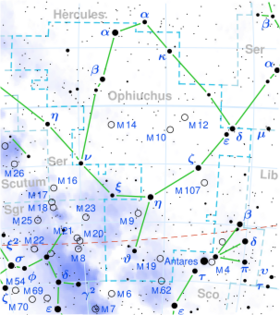Astronomy:Xi Ophiuchi
| Observation data Equinox J2000.0]] (ICRS) | |
|---|---|
| Constellation | Ophiuchus |
| Right ascension | 17h 21m 00.37452s[1] |
| Declination | −21° 06′ 46.5710″[1] |
| Apparent magnitude (V) | 4.39[2] |
| Characteristics | |
| Spectral type | F2V[3] |
| U−B color index | -0.06[4] |
| B−V color index | +0.41[4] |
| Astrometry | |
| Radial velocity (Rv) | −8.73±0.12[1] km/s |
| Proper motion (μ) | RA: +265.543[1] mas/yr Dec.: -202.584[1] mas/yr |
| Parallax (π) | 57.0820 ± 0.1851[1] mas |
| Distance | 57.1 ± 0.2 ly (17.52 ± 0.06 pc) |
| Absolute magnitude (MV) | 3.19[2] |
| Details[5] | |
| A | |
| Mass | 1.30 M☉ |
| Radius | 1.59±0.06 R☉ |
| Luminosity | 4.429±0.035[6] L☉ |
| Surface gravity (log g) | 4.15±0.10 cgs |
| Temperature | 6,611±80 K |
| Metallicity [Fe/H] | −0.27±0.07 dex |
| Rotational velocity (v sin i) | 20.2±0.7 km/s |
| Age | 916[7] Myr |
| Other designations | |
| Database references | |
| SIMBAD | data |
ξ Oph, Latinized as Xi Ophiuchi, is a visual binary star[9] system in the equatorial constellation of Ophiuchus.[2] It has a yellow-white hue and is faintly visible to the naked eye with a combined apparent visual magnitude of 4.39.[2] The system is located approximately 57.1 light-years (17.5 parsecs) away from the Sun based on parallax, but is drifting closer with a radial velocity of -9 km/s.[1]
The magnitude 4.40[10] primary, designated component A, is an ordinary F-type main-sequence star with a stellar classification of F2V.[3] It is 916[7] million years old and is rotating with a projected rotational velocity of 20 km/s. The star has 1.3 times the mass of the Sun and 1.6 times the Sun's radius.[5] It is radiating 4.4[6] times the luminosity of the Sun from its photosphere at an effective temperature of 6,611 K.[5]
The system is a source of X-ray emission.[11] The orbiting companion, component B, is a magnitude 8.9 star at an angular separation of 35″ along a position angle of 27° from the primary, as of 2015. A magnitude 10.8 visual companion, component C, lies at a separation of 10.8″, as of 2004.[10]
According to Richard H. Allen's Star Names: Their Lore and Meaning (1899), ξ Oph together with θ Oph formed the Sogdian Wajrik "the Magician", the Khorasmian Markhashik "the Serpent-bitten" and with η Oph the Coptic Tshiō, "the Snake", and Aggia, "the Magician".[12]
References
- ↑ 1.0 1.1 1.2 1.3 1.4 1.5 Vallenari, A. et al. (2022). "Gaia Data Release 3. Summary of the content and survey properties". Astronomy & Astrophysics. doi:10.1051/0004-6361/202243940 Gaia DR3 record for this source at VizieR.
- ↑ 2.0 2.1 2.2 2.3 Anderson, E.; Francis, Ch. (2012). "XHIP: An extended hipparcos compilation". Astronomy Letters 38 (5): 331. doi:10.1134/S1063773712050015. Bibcode: 2012AstL...38..331A. Vizier catalog entry
- ↑ 3.0 3.1 Gray, R. O.; Corbally, C. J.; Garrison, R. F.; McFadden, M. T.; Bubar, E. J.; McGahee, C. E.; O'Donoghue, A. A.; Knox, E. R. (2006). "Contributions to the Nearby Stars (NStars) Project: Spectroscopy of Stars Earlier than M0 within 40 pc--The Southern Sample". The Astronomical Journal 132 (1): 161–170. doi:10.1086/504637. Bibcode: 2006AJ....132..161G.
- ↑ 4.0 4.1 Mallama, A. (2014). "Sloan Magnitudes for the Brightest Stars". The Journal of the American Association of Variable Star Observers 42 (2): 443. Bibcode: 2014JAVSO..42..443M.Vizier catalog entry
- ↑ 5.0 5.1 5.2 Fuhrmann, K.; Chini, R.; Kaderhandt, L.; Chen, Z. (2017). "Multiplicity among Solar-type Stars". The Astrophysical Journal 836 (1): 139. doi:10.3847/1538-4357/836/1/139. Bibcode: 2017ApJ...836..139F.
- ↑ 6.0 6.1 Brown, A. G. A. (August 2018). "Gaia Data Release 2: Summary of the contents and survey properties". Astronomy & Astrophysics 616: A1. doi:10.1051/0004-6361/201833051. Bibcode: 2018A&A...616A...1G. Gaia DR2 record for this source at VizieR.
- ↑ 7.0 7.1 David, Trevor J.; Hillenbrand, Lynne A. (2015). "The Ages of Early-Type Stars: Strömgren Photometric Methods Calibrated, Validated, Tested, and Applied to Hosts and Prospective Hosts of Directly Imaged Exoplanets". The Astrophysical Journal 804 (2): 146. doi:10.1088/0004-637X/804/2/146. Bibcode: 2015ApJ...804..146D. Vizier catalog entry
- ↑ "ksi Oph". SIMBAD. Centre de données astronomiques de Strasbourg. http://simbad.u-strasbg.fr/simbad/sim-basic?Ident=ksi+Oph.
- ↑ Eggleton, P. P.; Tokovinin, A. A. (September 2008). "A catalogue of multiplicity among bright stellar systems". Monthly Notices of the Royal Astronomical Society 389 (2): 869–879. doi:10.1111/j.1365-2966.2008.13596.x. Bibcode: 2008MNRAS.389..869E.
- ↑ 10.0 10.1 Mason, Brian D. et al. (200). "The 2001 US Naval Observatory Double Star CD-ROM. I. The Washington Double Star Catalog". The Astronomical Journal 122 (6): 3466. doi:10.1086/323920. Bibcode: 2001AJ....122.3466M. Vizier catalog entry
- ↑ Haakonsen, Christian Bernt; Rutledge, Robert E. (September 2009). "XID II: Statistical Cross-Association of ROSAT Bright Source Catalog X-ray Sources with 2MASS Point Source Catalog Near-Infrared Sources". The Astrophysical Journal Supplement 184 (1): 138–151. doi:10.1088/0067-0049/184/1/138. Bibcode: 2009ApJS..184..138H.
- ↑ Allen, R.H. (1899), Star Names: Their Lore and Meaning, p. 297, https://penelope.uchicago.edu/Thayer/E/Gazetteer/Topics/astronomy/_Texts/secondary/ALLSTA/Ophiuchus*.html
 |


